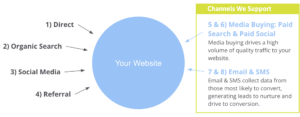Blueprint for a Healthy Digital Marketing Strategy in 2023
When planning your digital marketing strategy for 2023, consider where we are now and, more importantly, where we’re headed.
Whether you’re trimming expenses to prepare for a potential recession or expanding your ad spend to capture more market share when others may be dialing back, several key components will help you not only survive the new year but thrive in it.
Your marketing technology stack might change, platforms will come and go, and the specifics of leveraging individual tools might evolve, but the overall goal for e-commerce brands doesn’t change. They must build interest with (and adjacent to) their audience, drive potential customers to their site, and convert them. Then they need to convert them again and again and again, maximizing customer lifetime value.
That’s it, end of the story. A healthy digital strategy allows brands to do just that, adapting as the technologies change but keeping their eye on the prize.
What does it look like? Let’s dive into our blueprint for a healthy digital marketing strategy.
First Things First
First, ads drive quality traffic for new customer acquisition. Then email/SMS ensures customer retention by capturing zero and first-party data and serving customers an ideal, consistent experience.
Media buying provides the acquisition, qualifying, and driving new users to the website. Email/SMS, along with onsite behavior data, retains that audience as a low-cost remarketing channel, leveraging owned data. Using systems like Klaviyo for email/SMS, brands build audience lists, maximize ROI, and increase customer lifetime value.
Using these two channels, brands must capture data from traffic and guide users through the final stage toward a conversion. Media buying and email/SMS work together holistically to provide a high-value return on a brand’s marketing strategy.
Let’s dig in.
8 Primary Channels
People come to a brand’s website from 8 primary channels. The first four are 1) direct, 2) organic search, 3) social media, and 4) referral. These 4 channels are important for brands seeking online success. Still, they require a long-term, multi-year substantial investment before they become a meaningful source of traffic, particularly because success for these channels relies on people already knowing who they are.

So how do brands start building awareness? That’s where the other four channels come into play – 5) paid search, 6) paid social media, 7) email marketing, and 8) SMS marketing.
Paid search and paid social media are the two primary media buying channels. Email/SMS marketing is used for lead nurturing and customer retention.
Leveraging the last four channels, brands can move the needle today, getting ads in front of the proper audience and using email/SMS to capture users, communicate and nurture, engaging that audience and turning them into customers in a fraction of the time.
We focus on media buying for acquisition, consisting of search marketing and social media advertising. Email/SMS are used for customer retention, but let’s look at how these work in a little more detail.
Our ongoing marketing process starts with the following 8-step process.
- Define goals and develop a strategy to reach those goals. This includes things like, how many emails do we need to be sending? What kind of offer do we need to have in terms of capturing emails? What’s our ad spend? What platforms are we advertising on?
- Setup and implementation of the above.
- Start attracting new subscribers with those ads that we talked about.
- Convert customers and grow email list.
- Retarget shoppers and browsers. When users visit a website, ideally, they’re either buying, or they’re providing their email address in exchange for an asset. If the latter, brands can retarget these users because they’re closer to the bottom of the purchase funnel.
- Use remarketing, email/SMS to drive repeat sales and grow that lifetime value.
- Optimize your omnichannel campaign. After three months, six months, brands start to get meaningful data from their marketing efforts and they start to see opportunities for improvement, especially when they look at year-over-year trends.
- Increase lifetime value and then keep going. After six months or a year, take a step back, look at what’s been achieved, and then define new goals and see do we need to pivot on the strategy. Do we need to develop a new strategy? Do we need to add another ad platform?
Media Buying
Now let’s dive into media buying in a little more detail.
Brands can run ads on a lot of different platforms online. The two primary networks we leverage at the end of 2022 are Google and Meta.
Meta is Facebook and Instagram. While these are currently still the big player in social, depending on the brand, the audience, and the budget, we’ll always explore additional social channels given the opportunity. The more a brand has to spend, the more opportunity there is to explore platforms like TikTok, Bing, Connected tv, Amazon, etc.
Regardless of platform, media buying can be broken into two basic categories:
- Paid search targets people based on specific terms they’re searching for online.
- Paid social targets people based on what we know about them, their behavior, their interests, and their activities.
There are two primary audiences we care about:
- People who already know who a brand is, like when someone searches for a brand name, they’ve been to their site, or they follow them on social media.
- People who don’t know who a brand is, like when someone searches for a product or service they offer or shows an interest in something related to their offering.
The bottom line, we want to make sure we’re capturing everybody. Our strategy finds both audiences wherever they are online and ensures the highest quality leads end up coming to a brand’s site for the lowest possible cost.
Email/SMS Marketing
Ads drive quality traffic, and then email/SMS ensures retention and increased customer lifetime value. While new customer acquisition platforms like YouTube, Google and Instagram often necessitate a component of paid ad placement, email/SMS marketing is an owned media channel meaning brands can control their campaigns and audiences without paying for every single touchpoint.
This is why it’s important to build customer data over time and create a database of customers and leads. We use forms and site tracking to capture zero and first-party data from the highest-quality leads from all traffic.
So what does that mean? Let’s look at an example. Let’s pretend a user visits a website, and if they’re not in our email list, we’ll show them a 15% off code. If they put in their email address and phone number, they get 15% off. Then we’ll collect data once they sign up and see and keep track of their viewing, browsing, and abandoned cart behavior, and then send them triggered emails based on that behavior.
Use forms of site traffic to collect data, and then use campaigns to follow up with people and nurture that audience. Then, leveraging automations, like an abandoned cart flow, brands can convert those people over time.
Retargeting
Using the behavior we learned in that previous email flow, we’ll learn that some people became customers and some people didn’t. Some viewed a bunch of products, some people didn’t. Or perhaps some people purchased something they haven’t in a long time.
Taking all that information, we then rinse & repeat, using zero and first-party data to optimize our ads and to segment campaigns triggering automations based on actions, behavior, etc.
In Summary
Our clients’ emails see 20% higher open rates, 100% higher click rates, and 200% higher conversion rates on industry averages by simply following the above framework. Generating an average return on investment of over 5x, our team of marketing pros generates over 10 million website visits and a hundred million in sales every year for our clients. We can do the same for your e-commerce brand.
Other Articles
Mastering Black Friday Cyber Monday Campaigns: Strategies for Outdoor Retail Brands
Black Friday Cyber Monday (BFCM) has become a pivotal period for businesses across various industries, and the outdoor retail sector...
Why Leveraging Discounts Can Give Your Business a Competitive Edge
Consumers today have an infinite amount of information at their fingertips. Amid the sea of brands and products they have...
Navigating the Off-Season: Marketing Strategies for Outdoor, Overlanding, and Camping Brands
The world of outdoor adventure, overlanding, and camping is fueled by the passion for exploration, nature, and the thrill of...



